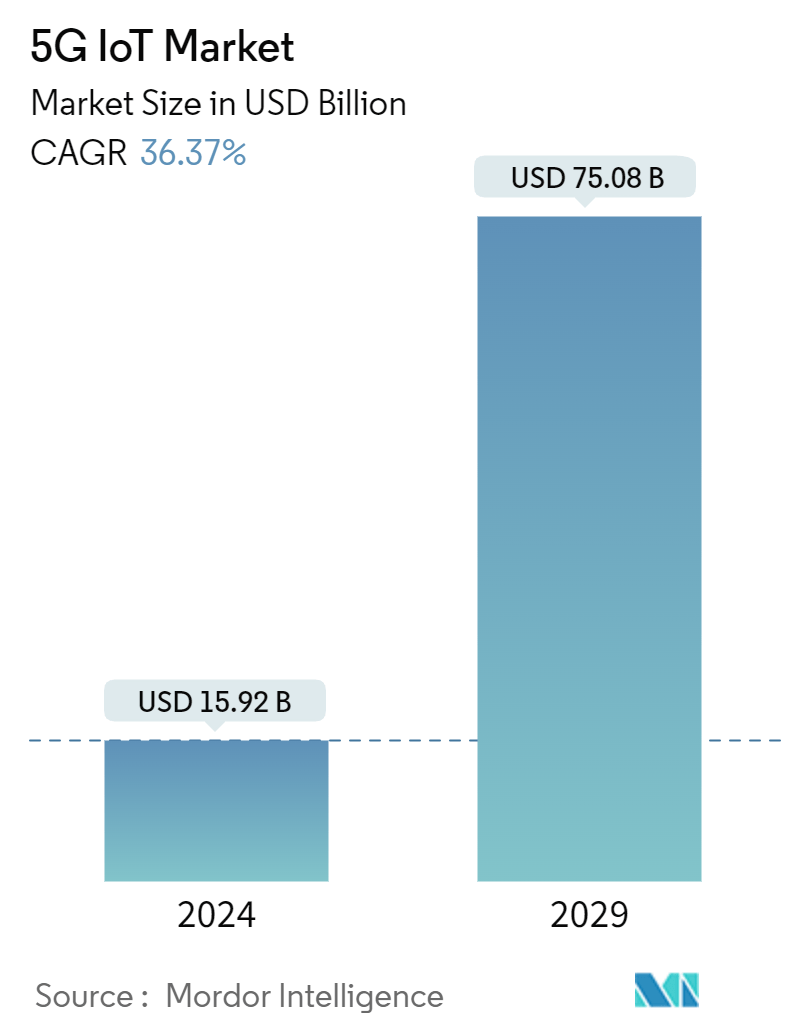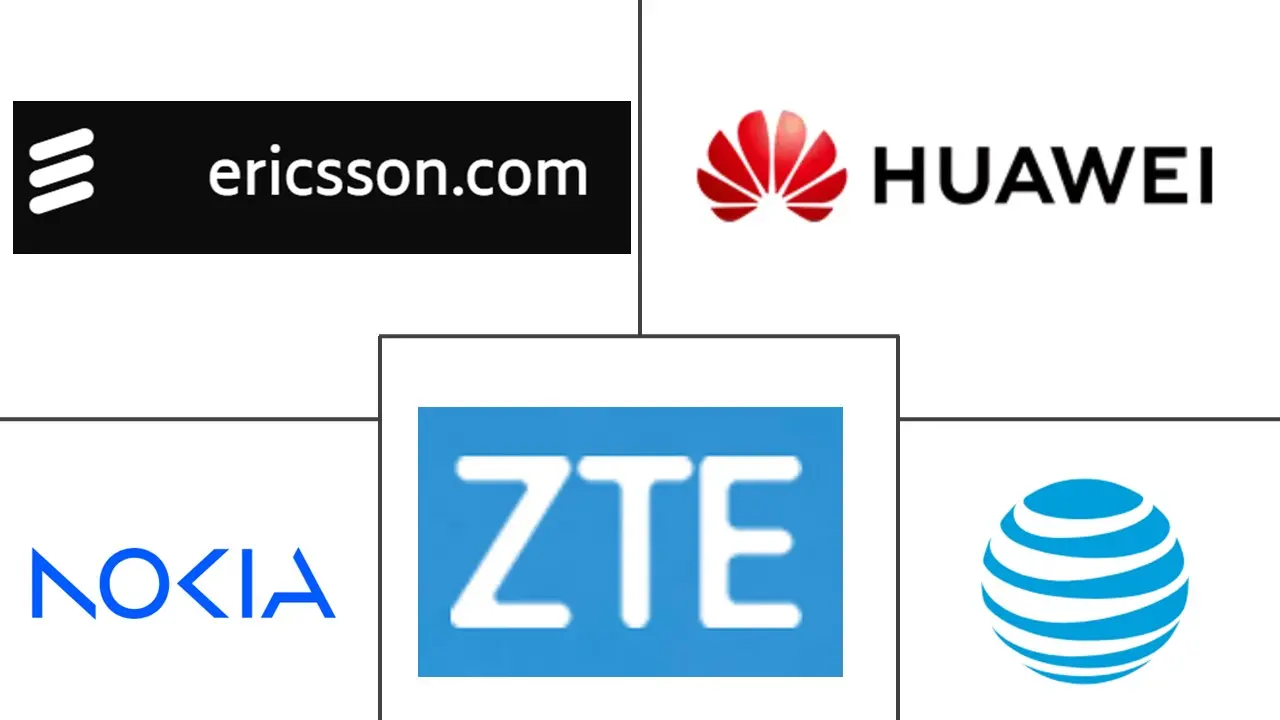Market Size of 5G IoT Industry

| Study Period | 2019 - 2029 |
| Market Size (2024) | USD 15.92 Billion |
| Market Size (2029) | USD 75.08 Billion |
| CAGR (2024 - 2029) | 36.37 % |
| Fastest Growing Market | Asia Pacific |
| Largest Market | North America |
Major Players
*Disclaimer: Major Players sorted in no particular order |
5G Internet of Things (IoT) Market Analysis
The 5G IoT Market size is estimated at USD 15.92 billion in 2024, and is expected to reach USD 75.08 billion by 2029, growing at a CAGR of 36.37% during the forecast period (2024-2029).
The 5G IoT market is poised to revolutionize how connected devices interact across various industries, leveraging the high-speed, low-latency capabilities of 5G networks. This technology enables a new level of connectivity for the Internet of Things (IoT), facilitating seamless communication between millions of devices. The integration of 5G into IoT networks is driving significant advancements in industries such as manufacturing, healthcare, and smart cities, where real-time data exchange and ultra-reliable communications are crucial.
- With 5G IoT technology, industries are witnessing an evolution in how data is collected, analyzed, and utilized, leading to enhanced operational efficiencies and the creation of innovative solutions. The market's growth is underpinned by the advantages 5G offers over existing LTE networks, including reduced latency, higher data throughput, and the capacity to connect a vast number of IoT devices simultaneously. However, the transition to 5G also comes with challenges, particularly the need for substantial infrastructure upgrades and the ongoing relevance of 4G LTE for certain IoT use cases.
Enhanced Connectivity: A Game-Changer for IoT Networks
- Unprecedented Device Handling Capabilities: The ability of 5G IoT technology to support a massive number of IoT devices is one of its most significant strengths. In industries like smart cities and manufacturing, the sheer volume of connected devices necessitates a network that can manage and maintain reliable connections across all devices. 5G IoT networks excel in this aspect, enabling real-time data exchange that is essential for automated processes, smart infrastructure, and large-scale IoT ecosystems. This capability significantly enhances industry operations, driving greater efficiency and opening new avenues for IoT applications that were previously unattainable with older network technologies.
- Low Latency and Critical Application Support: The low latency provided by 5G IoT networks is pivotal for applications requiring instantaneous data transmission. In healthcare, for example, 5G IoT devices facilitate real-time monitoring and remote surgeries, where any delay could be critical. Similarly, in the automotive industry, 5G supports the development of autonomous vehicles, where split-second decisions are necessary for safety. These critical applications highlight the transformative impact of 5G IoT solutions, as they enable new use cases that demand ultra-reliable and low-latency communication, which 4G LTE cannot adequately support.
Infrastructure Challenges: Balancing Cost and Innovation
- Existing 4G LTE Sufficiency for Certain Use Cases: While 5G IoT technology offers significant benefits, there are scenarios where existing 4G LTE networks are still sufficient, particularly for less demanding IoT applications. Some industries may find that the current 4G infrastructure meets their needs without requiring the expensive transition to 5G. This is especially true for use cases where low bandwidth and lower device density are acceptable, such as in basic monitoring systems or non-critical data collection scenarios. The sufficiency of 4G LTE in these contexts can slow the adoption of 5G, as companies weigh the costs and benefits of upgrading.
- High Costs of Infrastructure Upgrades: The transition from LTE to 5G involves considerable investment, particularly in upgrading the existing infrastructure. The costs associated with deploying 5G networks, including the installation of new antennas, network configurations, and the procurement of 5G-enabled devices, are substantial. This financial burden can be a significant barrier for industries looking to adopt 5G IoT solutions, especially in regions where 4G infrastructure is still relatively new. Companies must balance the long-term benefits of 5G IoT adoption with the immediate financial outlay, which may delay widespread implementation.
The 5G IoT market is at a critical juncture where the potential for groundbreaking advancements is tempered by the practical challenges of infrastructure development and cost considerations. As industries continue to explore the full capabilities of 5G IoT networks, the balance between innovation and cost will play a crucial role in shaping the market's future trajectory.
5G Internet of Things (IoT) Industry Segmentation
The 5G IoT market involves developing, producing, and implementing 5G-enabled IoT devices, sensors, and modules that communicate seamlessly over 5G networks. These devices can range from smart home appliances and wearable gadgets to industrial sensors, connected vehicles, and infrastructure components.
The 5G IoT Market is segmented by technology (ultra-reliable low-latency communications (URLLC), low-power wide-area network (LPWAN), by end-user industry (manufacturing, supply chain, healthcare, retail, smart cities, automotive), by geography (North America (United States, Canada, Mexico, rest of North America), Europe (Germany, United Kingdom, France, Russia, Spain, rest of Europe), Asia Pacific (India, China, Japan, rest of Asia Pacific), South America (Brazil, Argentina, rest of South America), Middle East and Africa (UAE, Saudi Arabia, Africa).
The market sizes and forecasts are provided in terms of value in USD for all the above segments.
| By Technology | |
| Ultra-Reliable Low-Latency Communications (URLLC) | |
| Low-Power Wide-Area Network (LPWAN) |
| By End-User Industry | |
| Manufacturing | |
| Supply Chain | |
| Healthcare | |
| Retail | |
| Smart Cities | |
| Automotive |
| By Geography*** | |||||||
| |||||||
| |||||||
| |||||||
| Australia and New Zealand | |||||||
| |||||||
|
5G IoT Market Size Summary
The 5G IoT market is poised for significant expansion, driven by the need for faster and more reliable connectivity to support the growing number of interconnected devices. The transition to 5G technology is crucial for the Internet of Things, as it offers enhanced bandwidth, low latency, and the ability to connect numerous devices simultaneously. This capability is particularly beneficial for industries requiring real-time data processing, such as automotive and industrial sectors. The automotive industry, in particular, benefits from 5G's ultra-fast connectivity, enabling advanced vehicle-to-everything (V2X) communication, which enhances safety and efficiency in transportation. Despite the advantages, the high cost of upgrading infrastructure from LTE to 5G presents a challenge for market growth, especially in certain regions and industries.
North America has emerged as a leader in the 5G IoT market, with significant investments in 5G infrastructure by major telecommunications companies. The region's early adoption of 5G has fostered a robust ecosystem for various IoT applications, including smart city initiatives and industrial IoT solutions. The high-speed, low-latency connectivity of 5G enhances real-time data analytics and remote monitoring capabilities, driving economic growth and job creation. The market is highly fragmented, with key players like Nokia, AT&T, Huawei, Ericsson, and ZTE actively engaging in partnerships and acquisitions to strengthen their market position. These companies are exploring new 5G use cases and leveraging emerging technologies such as artificial intelligence and machine learning to optimize network performance and user experience.
5G IoT Market Size - Table of Contents
-
1. MARKET INSIGHTS
-
1.1 Market Overview
-
1.2 Industry Attractiveness - Porter's Five Forces Analysis
-
1.2.1 Bargaining Power of Suppliers
-
1.2.2 Bargaining Power of Buyers/Consumers
-
1.2.3 Threat of New Entrants
-
1.2.4 Threat of Substitute Products
-
1.2.5 Intensity of Competitive Rivalry
-
-
1.3 Technology Snapshot
-
-
2. MARKET SEGMENTATION
-
2.1 By Technology
-
2.1.1 Ultra-Reliable Low-Latency Communications (URLLC)
-
2.1.2 Low-Power Wide-Area Network (LPWAN)
-
-
2.2 By End-User Industry
-
2.2.1 Manufacturing
-
2.2.2 Supply Chain
-
2.2.3 Healthcare
-
2.2.4 Retail
-
2.2.5 Smart Cities
-
2.2.6 Automotive
-
-
2.3 By Geography***
-
2.3.1 North America
-
2.3.1.1 United States
-
2.3.1.2 Canada
-
2.3.1.3 Mexico
-
-
2.3.2 Europe
-
2.3.2.1 Germany
-
2.3.2.2 United Kingdom
-
2.3.2.3 France
-
2.3.2.4 Russia
-
2.3.2.5 Spain
-
-
2.3.3 Asia
-
2.3.3.1 India
-
2.3.3.2 China
-
2.3.3.3 Japan
-
-
2.3.4 Australia and New Zealand
-
2.3.5 South America
-
2.3.5.1 Brazil
-
2.3.5.2 Argentina
-
-
2.3.6 Middle East and Africa
-
2.3.6.1 United Arab Emirates
-
2.3.6.2 Saudi Arabia
-
2.3.6.3 Africa
-
-
-
5G IoT Market Size FAQs
How big is the 5G IoT Market?
The 5G IoT Market size is expected to reach USD 15.92 billion in 2024 and grow at a CAGR of 36.37% to reach USD 75.08 billion by 2029.
What is the current 5G IoT Market size?
In 2024, the 5G IoT Market size is expected to reach USD 15.92 billion.

